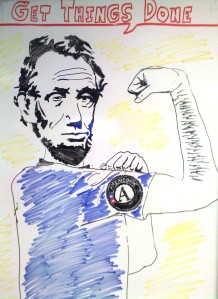
Joe Shlabotnik
My college friend Laurie asked for recommendations – best places to volunteer with her kid. Too many thoughts for a quick Facebook response, so I wrote this post!
If you want to volunteer with your child, here are some questions to start with.
What can your child do and what do they like to do?
If your child can do something, they can volunteer that skill. Bonus if they enjoy it.
Read, paint/color, fold laundry, play games, bake pies, pick up litter, sweep, vacuum, rake, tell knock-knock jokes, write letters, run, bike, sell things (stand at a busy spot, look cute, and call attention to the cause)…all of these are volunteerable skills.
What places do your family members already frequent?
Volunteering where you already go is a great choice for children because they are investing in a place that has brought them joy already, and where they can return to see they fruits of their labor.
Schools always need volunteers, even children! Older kids can help set up and take down chairs for special events, help babysit younger kids during parent meetings, and run movie nights or other social events.
Libraries, after-school programs, and preschools may welcome big kid readers.
Parks and playgrounds have formal volunteering (groundskeeping, etc.), as well as informal volunteering — picking up litter, toweling off playground equipment after a rain, reporting graffiti to the parks office.
Theatres and concert halls need ushers, and also people to pick up old programs and trash after the performance. Children’s productions might be more kid-friendly, and allow your child to watch a program for free.
If your family has a faith community, look for ways to volunteer through your temple, mosque, or church — visiting elderly and home bound members of the community, raking the grounds, making meals for people who sleep outside, or passing out flyers for an upcoming blood drive are some examples.
What kind of issues or people are important to your child?

saritarobinson
Children’s hospitals may welcome children to come and play games or read with patients. Your family could lead or participate in a clothing, toy or stuffed animal drive, and donate needed items to the hospital. (Confer with the hospital prior to collecting items!)
If your child likes animals, you may find an animal shelter, zoo, or rehabilitation organization that welcomes regular and loving visits from children.
Children who have close relationships with their grandparents may enjoy creating colorful cards and greetings to share with Meals on Wheels groups in your community, to distribute along with meals to home bound older adults. Local assisted-living facilities may welcome your child at certain times to spend time with the residents.
If your child has struggled to understand homelessness and panhandling on your city’s streets, you might bake desserts to bring to a nonprofit that feeds people for free (ask for guidance first), or get together with friends to assemble care packages to distribute on the streets.
What values would you like to demonstrate or strengthen?
While the suggestions above are child-centered, you as a parent might be interested in broadening your child’s horizon, sharing with them something you care about.
Parents with a deep sense of environmental justice might want to introduce their children to the importance of clean waterways — to protect aquatic animals from eating toxins. Picking up litter during beach or river cleanups is a way to volunteer. Or parents may help their children understand the danger posed by invasive plant species — by identifying and clearing invasive species in natural areas.
Parents who care about maternal and child health in low-income communities can find ways to collect and pass along baby clothes and gear, parenting books, and other resources to high schools and community centers. Children can fold clothes, organize their friends’ families to donate, and help carry donations.
And of course there’s the lemonade stand — with proceeds going to organizations you and your child value. Similarly, there are charity fun runs and family bike rides where the volunteering is an athletic contest, and the benefit is the financial support of an organization you value. Some “friends of rivers” organizations even offer canoe rides!
Do you want to volunteer with a group, DIY, or with an individual organization?
A final question to ask is whether you want to volunteer with a group like the Scouts or a youth group, OR whether you want to create your own volunteer gig, or whether your child wants to become a regular/formal volunteer with a specific organization. Asking this question can help you narrow your options and hopefully help you pick a way to start!


